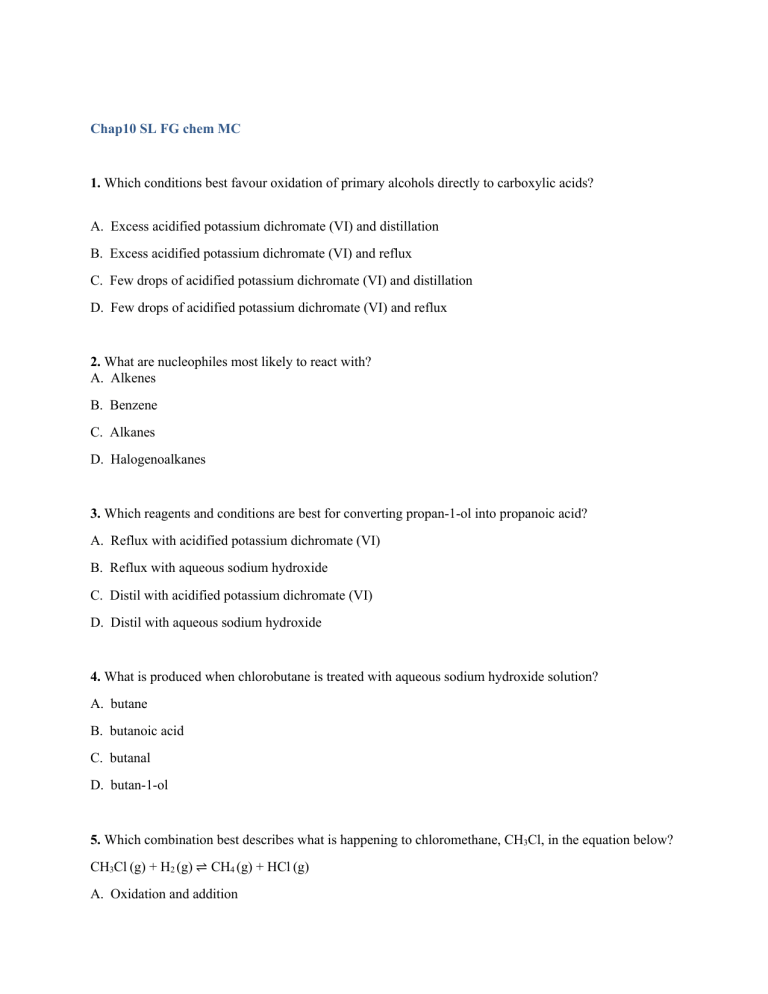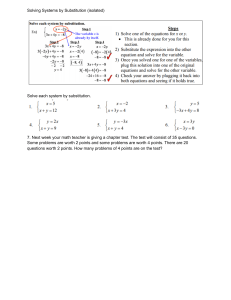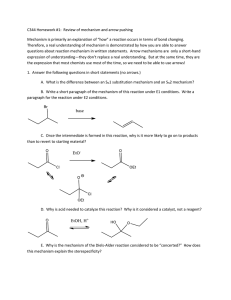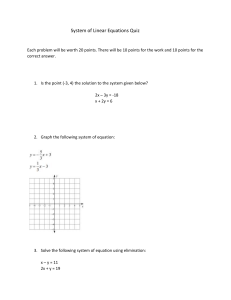
Chap10 SL FG chem MC 1. Which conditions best favour oxidation of primary alcohols directly to carboxylic acids? A. Excess acidified potassium dichromate (VI) and distillation B. Excess acidified potassium dichromate (VI) and reflux C. Few drops of acidified potassium dichromate (VI) and distillation D. Few drops of acidified potassium dichromate (VI) and reflux 2. What are nucleophiles most likely to react with? A. Alkenes B. Benzene C. Alkanes D. Halogenoalkanes 3. Which reagents and conditions are best for converting propan-1-ol into propanoic acid? A. Reflux with acidified potassium dichromate (VI) B. Reflux with aqueous sodium hydroxide C. Distil with acidified potassium dichromate (VI) D. Distil with aqueous sodium hydroxide 4. What is produced when chlorobutane is treated with aqueous sodium hydroxide solution? A. butane B. butanoic acid C. butanal D. butan-1-ol 5. Which combination best describes what is happening to chloromethane, CH3Cl, in the equation below? CH3Cl (g) + H2 (g) ⇌ CH4 (g) + HCl (g) A. Oxidation and addition B. Oxidation and substitution C. Reduction and addition D. Reduction and substitution 6. Which structure represents a repeating unit of a polymer formed from propene? A. –CH2–CH(CH3)– B. –CH2–CH2–CH2– C. –CH(CH3)–CH(CH3)– D. –CH2–CH2– 7. Which reaction mechanisms are typical for alcohols and halogenoalkanes? 8. What is formed in a propagation step of the substitution reaction between bromine and ethane? A. CH3CH2• B. CH3CH2CH2CH3 C. H• D. Br− 9. Which monomer would produce the polymer shown? A. CF! CCl" F B. CF! CClHF C. CF" CClF D. CF" CF" 10. Which monomer forms the polymer shown? A. CH(Cl) = CH(CH! ) B. CH" = C(Cl)CH! C. (CH! )" CHCl D. CH" = CHCl 11. Which is a propagation step in the free-radical substitution mechanism of ethane with chlorine? A. Cl2 → 2 •Cl B. •C2H5 + Cl2 → C2H5Cl + •Cl C. •C2H5 + •Cl → C2H5Cl D. C2H6 + •Cl → C2H5Cl + •H 12. Which molecule will decolorize bromine water in the dark? A. cyclohexane B. hexane C. hex-1-ene D. hexan-1-ol 13. Which mechanism does benzene most readily undergo? A. Nucleophilic substitution B. Electrophilic substitution C. Electrophilic addition D. Free radical substitution 14. What type of reaction occurs when C6H13Br becomes C6H13OH? A. Nucleophilic substitution B. Electrophilic substitution C. Radical substitution D. Addition 15. Which will react with a halogen by an electrophilic substitution mechanism? 16. Which compound cannot undergo addition polymerization? 17. What is the mechanism of the reaction between alkenes and halogens in the absence of light? A. radical substitution B. electrophilic substitution C. electrophilic addition D. nucleophilic substitution 18. Which alcohol would produce a carboxylic acid when heated with acidified potassium dichromate(VI)? A. propan-2-ol B. butan-1-ol C. 2-methylpropan-2-ol D. pentan-3-ol 19. Which of the following can be both formed from bromoethane and converted directly into ethanal? CH3CH2Br → X X → CH3CHO A. CH3CH2OH B. CH3OCH3 C. CH3COOH D. H2C=CHBr 20. Methane reacts with chlorine in sunlight. CH4 (g) + Cl2 (g) → CH3Cl (g) + HCl (g) Which type of reaction occurs? A. free-radical substitution B. electrophilic substitution C. nucleophilic substitution D. electrophilic addition 21. Which compounds cause the colour of acidified potassium manganate(VII) solution to change from purple to colourless? I. CH3CH2CH2CH2OH II. (CH3)3CCH2OH III. CH3CH2CH(OH)CH3 A. I and II only B. I and III only C. II and III only D. I, II and III 22. Which compounds react to form CH3CH2CH2COOCH(CH3)2? A. propanoic acid and propan-2-ol B. propanoic acid and butan-2-ol C. butanoic acid and propan-1-ol D. butanoic acid and propan-2-ol 23. What is the product of the reaction between hex-3-ene and steam? A. Hexan-1-ol B. Hexan-2-ol C. Hexan-3-ol D. Hexan-4-ol 24. Which of these reactions proceeds by a free radical mechanism in the presence of UV light? A. C6H6 + Cl2 → C6H5Cl + HCl B. C6H6 + 3H2 → C6H12 C. CH2CH2 + HBr → CH3CH2Br D. CH3CH3 + Cl2 → CH3CH2Cl + HCl 25. Which compound could be formed when CH3CH2CH2OH is heated with acidified potassium dichromate(VI)? I. II. III. CH3CH2CHO CH3CH2COOH CH3COCH3 A. I and II only B. I and III only C. II and III only D. I, II and III 26. What is the mechanism for the reaction of propene with iodine in the dark? A. electrophilic addition B. electrophilic substitution C. free radical substitution D. nucleophilic substitution 27. What is the major product of the reaction between HCl and but-2-ene? A. 1,2-dichlorobutane B. 2,3-dichlorobutane C. 1-chlorobutane D. 2-chlorobutane 28. Which compound can be oxidized when heated with an acidified solution of potassium dichromate(VI)? A. CH3C(O)CH2CH3 B. CH3CH2CH(OH)CH3 C. (CH3)3COH D. CH3(CH2)2COOH 29. Which type of reaction occurs between an alcohol and a carboxylic acid? A. Addition B. Oxidation C. Esterification D. Polymerization 30. Which describes the reaction between a halogen and ethane?




